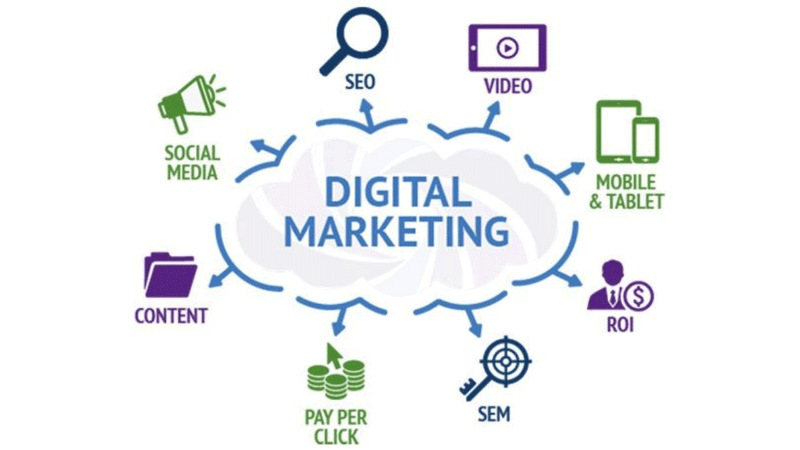Digital Marketing-Introduction
Digital marketing refers to the use of digital channels, platforms, and strategies to promote products, services, or brands and connect with potential customers or audiences. It encompasses various online marketing techniques and tactics that leverage digital technologies and the internet to reach and engage with target audiences effectively.
The introduction of digital marketing can be traced back to the widespread adoption of the internet and the rapid advancements in technology. As people increasingly shifted their attention and activities online, businesses recognized the need to adapt their marketing strategies to reach and engage with their target customers in the digital realm.
Digital marketing off Digital marketing refers to the use of digital channels, platforms, and strategies to promote products, services, or brands and connect with potential customers or audiences. It encompasses various online marketing techniques and tactics that leverage digital technologies and the internet to reach and engage with target audiences effectively.
ers several advantages over traditional marketing approaches:
Wide Reach: Digital marketing enables businesses to reach a global audience, breaking down geographical barriers and expanding their market potential.
Targeted Audience: With digital marketing, businesses can target specific demographics, interests, behaviours, and preferences of their ideal customers. This targeting allows for more personalized and relevant marketing messages.
Cost-Effective: Digital marketing often provides more cost-effective solutions than traditional marketing channels. Businesses can leverage various digital platforms and advertising models to reach their target audience while optimizing their marketing budget.
Measurable Results: Digital marketing allows for precise tracking and measurement of marketing efforts. Marketers can gather data on website traffic, ad impressions, clicks, conversions, and more. This data-driven approach helps in making informed decisions and optimizing marketing campaigns for better results.
Real-Time Engagement: Digital marketing enables businesses to engage with their audience in real time. Through social media, email marketing, chatbots, and other communication channels, companies can interact, respond to inquiries, and build relationships with their customers promptly.
 |
| Basics Requirements in this field |
Digital marketing comprises a wide range of tactics and strategies, including:
Search Engine Optimization (SEO): Optimizing websites and content to improve visibility in search engine results and drive organic traffic.
Search Engine Marketing (SEM): Running paid advertising campaigns on search engines, often utilizing pay-per-click (PPC) models like Google Ads.
Social Media Marketing: Promoting brands and engaging with audiences through various social media platforms like Facebook, Instagram, Twitter, LinkedIn, and others.
Content Marketing: Creating and distributing valuable, relevant, and consistent content to attract and retain a target audience.
Email Marketing: Sending targeted emails to nurture leads, build customer relationships, and promote products or services.
Influencer Marketing: Collaborating with influential individuals or online personalities to promote products or services to their dedicated followers.
Display Advertising: Placing banner ads, images, or videos on websites and apps to generate brand awareness and drive traffic.
Mobile Marketing: Optimizing marketing strategies and campaigns for mobile devices, including mobile apps, responsive websites, and SMS marketing.
Analytics and Data-driven Insights: Utilizing tools and analytics platforms to collect, analyze, and interpret data to make informed marketing decisions.
Digital marketing continues to evolve as technology advances, creating new opportunities and challenges for businesses to effectively reach and engage their target audience in the digital landscape.
WWW stands for World Wide Web. It is an information system that allows users to access and navigate interconnected documents and resources through the Internet. The WWW is not the same as the Internet itself; rather, it is a way of accessing and organizing information on the Internet.
The WWW is based on a client-server model, where clients (users) request information from servers (computers that host websites and webpages) using web browsers. Here's how it works:
URL and Web Address: The WWW is accessed through Uniform Resource Locators (URLs) or web addresses. A URL consists of multiple parts, including the protocol (such as HTTP or HTTPS), the domain name (e.g., www.example.com), and the specific path to the resource (such as /products/page.html).
Request and Response: When a user enters a URL into a web browser, the browser sends a request to the appropriate server. The request includes the desired resource (webpage, image, video, etc.) and other relevant information.
Server Processing: The server receives the request and processes it. It retrieves the requested resource from its storage and prepares a response to send back to the user's browser.
Transmission: The server sends the response, usually in the form of Hypertext Markup Language (HTML) code, back to the user's web browser. The response may also include other files such as CSS (Cascading Style Sheets), JavaScript, images, or multimedia content.
Rendering: The web browser receives the response and interprets the HTML code, rendering it into a visual representation of the webpage. This involves displaying text, formatting, images, links, and other elements according to the instructions provided in the HTML and associated files.
Hyperlinks: Webpages often contain hyperlinks, which are clickable elements that allow users to navigate to other web pages or resources. Clicking on a hyperlink triggers a new request to the server, initiating the process again.
Interaction and Forms: Webpages can include interactive elements like forms, buttons, and input fields. When a user interacts with these elements (e.g., submitting a form), the browser sends additional requests to the server to process the user's input and perform the requested action.
Client-Side Technologies: Modern web development often includes client-side technologies like JavaScript, which enables dynamic and interactive elements on web pages. JavaScript code is executed within the user's browser, allowing for enhanced functionality and user experience.
Overall, the WWW enables users to access and navigate a vast network of interconnected web pages and resources, facilitating information sharing, communication, and online interactions.


Comments
Post a Comment